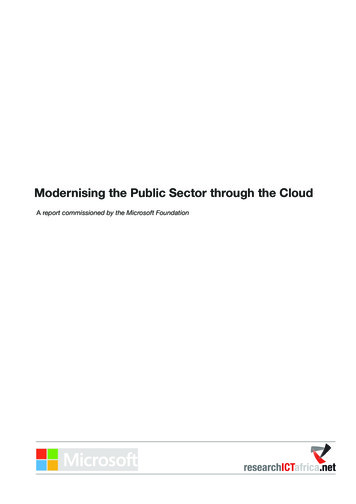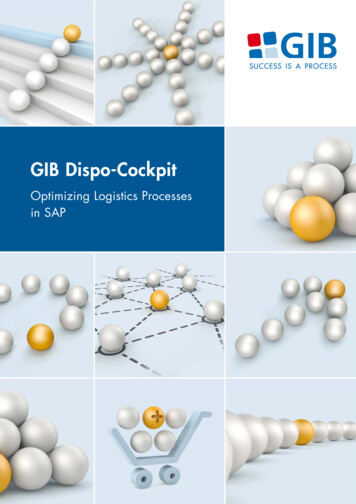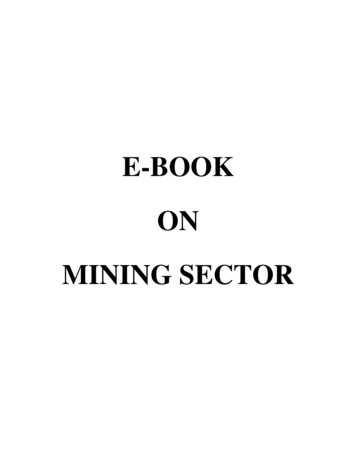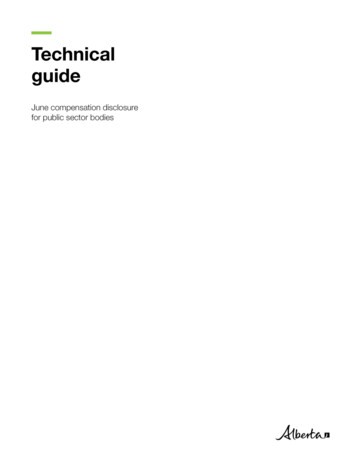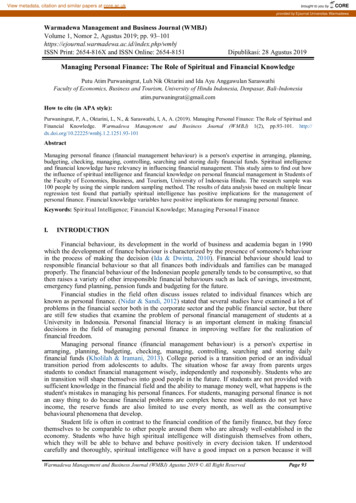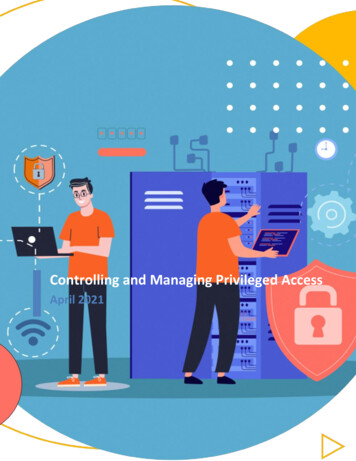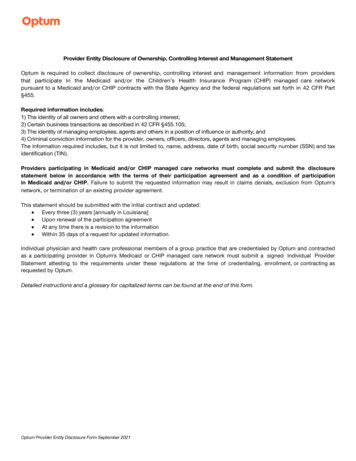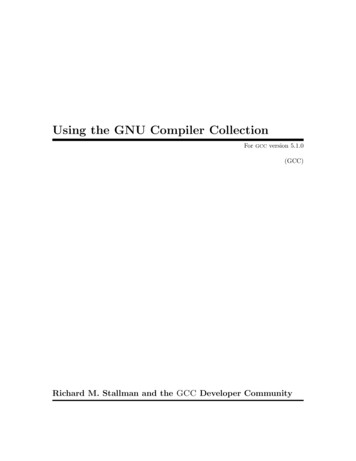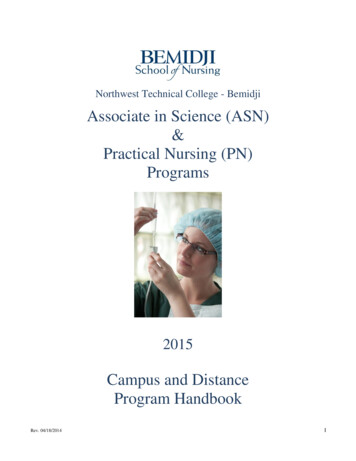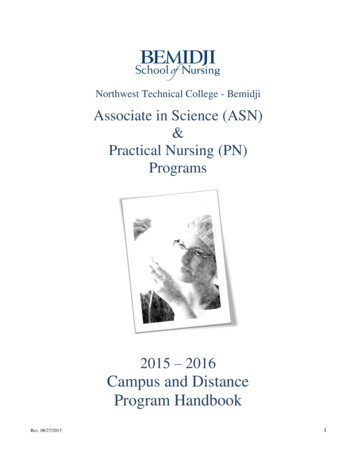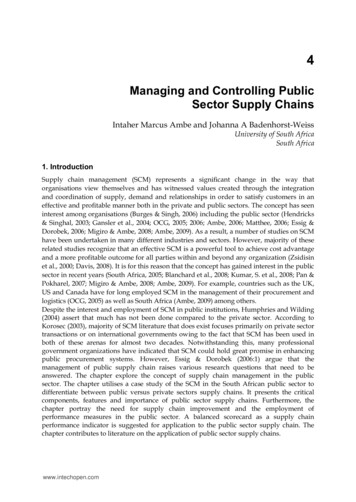
Transcription
4Managing and Controlling PublicSector Supply ChainsIntaher Marcus Ambe and Johanna A Badenhorst-WeissUniversity of South AfricaSouth Africa1. IntroductionSupply chain management (SCM) represents a significant change in the way thatorganisations view themselves and has witnessed values created through the integrationand coordination of supply, demand and relationships in order to satisfy customers in aneffective and profitable manner both in the private and public sectors. The concept has seeninterest among organisations (Burges & Singh, 2006) including the public sector (Hendricks& Singhal, 2003; Gansler et al., 2004; OCG, 2005; 2006; Ambe, 2006; Matthee, 2006; Essig &Dorobek, 2006; Migiro & Ambe, 2008; Ambe, 2009). As a result, a number of studies on SCMhave been undertaken in many different industries and sectors. However, majority of theserelated studies recognize that an effective SCM is a powerful tool to achieve cost advantageand a more profitable outcome for all parties within and beyond any organization (Zsidisinet al., 2000; Davis, 2008). It is for this reason that the concept has gained interest in the publicsector in recent years (South Africa, 2005; Blanchard et al., 2008; Kumar, S. et al., 2008; Pan &Pokharel, 2007; Migiro & Ambe, 2008; Ambe, 2009). For example, countries such as the UK,US and Canada have for long employed SCM in the management of their procurement andlogistics (OCG, 2005) as well as South Africa (Ambe, 2009) among others.Despite the interest and employment of SCM in public institutions, Humphries and Wilding(2004) assert that much has not been done compared to the private sector. According toKorosec (2003), majority of SCM literature that does exist focuses primarily on private sectortransactions or on international governments owing to the fact that SCM has been used inboth of these arenas for almost two decades. Notwithstanding this, many professionalgovernment organizations have indicated that SCM could hold great promise in enhancingpublic procurement systems. However, Essig & Dorobek (2006:1) argue that themanagement of public supply chain raises various research questions that need to beanswered. The chapter explore the concept of supply chain management in the publicsector. The chapter utilises a case study of the SCM in the South African public sector todifferentiate between public versus private sectors supply chains. It presents the criticalcomponents, features and importance of public sector supply chains. Furthermore, thechapter portray the need for supply chain improvement and the employment ofperformance measures in the public sector. A balanced scorecard as a supply chainperformance indicator is suggested for application to the public sector supply chain. Thechapter contributes to literature on the application of public sector supply chains.www.intechopen.com
74Supply Chain Management2. Supply chain management in the public sectorSupply chain management (SCM) is a term used in business literature to refer to the controlof materials, information, and finances as they move in a process from supplier tomanufacturer to wholesaler to retailer to consumer. The term supply chain is inspired by theproduct flow that should be delivered to citizens or businesses by passes through severalorganizations. According to the Council of Supply Chain Management Professionals(CSCMP, 2007), "Supply chain management encompasses the planning and management ofall activities involved in sourcing and procurement, conversion, and all logisticsmanagement activities. It also includes coordination and collaboration with channelpartners, which can be suppliers, intermediaries, third party service providers, andcustomers." In a functional sense, this focus on activities and relationships implies logistics,marketing, purchasing/supply, and production/operations are involved in SCM.In essence, SCM integrates supply and demand management within and acrossorganizations. A supply chain consists of all parties involved directly or indirectly infulfilling a customer request. It includes all functions involved in receiving and filling acustomer request. These functions include but are not limited to new product selection,procurement, marketing, operations, distribution, finance, and customer service. A supplychain, as opposed to supply chain management, is a set of organizations directly linked byone or more of the upstream and downstream flows of products, services, finances, andinformation from a source to a customer. Managing a supply chain is 'supply chainmanagement' (Mentzer et al., 2001). Each stage in a supply chain is connected through theflow of products, information, and funds.In the public sector, SCM is concerned with the “co-ordination of all parties involved indelivering the combination of inputs, outputs or outcomes that will meet a specified publicsector requirement.” These parties include external suppliers, partner organisations, andinternal corporate service units both inside and outside the organisation. The supply chainmay be inbound into the public sector. That is an operational requirement for internalcustomers for example, or it may be outbound from the public sector. That is in place todeliver wider organisational objectives to provide services for delivery to citizens, or acombination of both. Supply chains in the public sector addresses different focus areas. Thefocus of SCM can differ from government sector-to-sector and SCM can differ from industrysector-to-sector. An example of a government sector to sector focus area could be in thehealth sector, where the focus may be more on logistics and the effective movement ofgoods and services in and out of hospitals whereas SCM in the education sector may focuson streamlining the chain through which teaching materials are delivered to students. Theshape of the supply chain and the supply chain management processes employed will varyconsiderably depending on a range of different considerations (OGC, 2005).Public sector SCM offers a reference framework for the composition of public sector supplychains and multilevel networks (Migiro & Ambe, 2008). Actors in public sector supply chaincomprise (1) private firms which receive orders from public sector agents, (2) accountingofficers and (3) policy-makers. The SCM in the public sector not only concentrates on thequestion, which institutions cooperate in goods and services, but also how these enterprisesare involved with enterprises operating at other levels. Thus, analyses of intra-networkrelationships as well as analyses of inter-network-relationship are essentially necessaryelements of the concept.www.intechopen.com
Managing and Controlling Public Sector Supply Chains752.1 Importance of supply chain management in the public sectorSupply chains and their associated management processes often remain invisible to thepublic sector client. Government has traditionally focused on the contracting process withfirst tier suppliers, the supply chain members with whom the procuring organisationdirectly contracts. According to OGC, UK (2005), the 2004 Public accounts committee Reporton ‘Improving departments' capability to procure cost-effectively’ highlighted that only 17%of departments, agencies and non departmental public bodies analyse their suppliers’supply chains as part of their criteria for selecting suppliers and thus suffer from a lack ofassurances about the reliability and resilience of their key suppliers’ subcontractors. In 2004,OGC undertook a survey of central civil government (CCG) departments and key suppliersto the public sector looking at activities and attitudes in relation to SCM. The findingsreveals that 68% of respondents did not know how their main suppliers advertisedopportunities to potential new entrants to the SC, while 36% of respondents soughtfeedback from main suppliers’ subcontractors during contract delivery. In a surveyconducted in the local government sector by IdeA in 2004 to evaluate progress againstmilestones for the National Procurement Strategy for Local Government in the UK, denotedthat 41% of councils report that they invite bidders for partnership contracts to demonstratetheir track record in achieving value for money through their use of the supply chain,including use of small firms and only 39% track suppliers’ use of the supply chain incontract management.In the ‘A New World of Risk’ by Zurich Municipal (2009), a survey conducted by the Houseof Commons Public Accounts Committee’s 2009 report, on Central Government’sManagement of Service Contracts, indicated that the extent to which central governmenttests the value for money of ongoing services and contract changes is variable. 41% ofcontract managers do not test the value for money of new services purchased under anexisting contract. Planning and governance is one of the weaker areas of contractmanagement, and 30% of contracts where suppliers were dealing with personal or securityinformation did not have a risk register. In the Republic of South Africa (RSA), report onOpportunities for Reform of Government Procurement and Joint Country AssessmentReview (CPAR) conducted by the World Bank during 2001/2002 indicated that there weredivergent interpretations of government's objectives and strategies. The difficultieshighlighted was that, there were inadequate provisions to capacity building fordisadvantaged enterprises to successfully compete for government contracts. Also, thepreferential procurement policies were not clearly formulated and targets were not met. Theperformance of these initiatives did not take place in a holistic evaluation environment.Furthermore, the report revealed that the effective and efficient financial managementwithin government was questionable (National Treasury, RSA, 2005).Whilst it is relatively common, especially in complex procurements, for the first tiersupplier(s) to manage the supply chain on behalf of the contracting authority, relatively littleeffort has been made by the public sector to improve its visibility of SCs and its ability toexert influence over how the first tier supplier(s) manages this chain, except perhaps in theconstruction industry. The limited effort in other industries to improve supply chainperformance could be for reasons of simplicity, resource constraints, a lack of understandingor perceived need for understanding, or perhaps even a perception on the client side thatthe policy and legal framework does not allow for such activities. Increasingly, thecomplexity of many contracts, a greater appreciation of the need to improve competitionand innovation, and an increasing awareness of the impacts of terrorism or natural disasterswww.intechopen.com
76Supply Chain Managementon SCs and business continuity, means that wider supply chain issues increasingly need tobe taken into account in seeking improved efficiency and value for money. The supply chainis an area of strategic importance to an organisation due to the significant percentage ofoverall cost it accounts for. But is it strategic? In the commercial world companies seek tocreate competitive advantage, lowering their cost base to contribute to their bottom line, thatis profit. In the public sector the cost advantage gained through the procurement functioncontributes to lower costs for the organisation, enabling funds to be diverted to frontlineservices such as hospitals and schools. This means better value for money for public sectorshareholders that are taxpayers.As noted by Ambe (2009), countries such as the UK, US and Canada have long employedSCM in the management of their procurement and logistics. Gansler et al. (2004: 4)acknowledge that the Department of Defence (DOD) in the US have minimised cost throughlead time in the management of its logistics by employing SCM best practices. Also, theOffice of Government of Commerce (OGC) in the UK releases year to year updates aboutbest practices of SCM in the public sector. Luby [Consultant for Department of DefenseSupply Centres and Defense Supply Chain Leader with IBM Consulting Services (2004)]noted that“ the key to modernizing SCM in the private sector has been internal and externaldigital integration, including new linkages, procurement and finance operations. He however,suggested that governments can and must do more to adopt available and proven tools forimplementing a modern supply chain. These include: instant worldwide communications;interoperable, flexible and secure information technology; remote diagnostics and automateddecision-making aids and employ modern, high-speed transportation (Essig & Dorobek, 2006).Streamlining and modernising government supply chain can result in substantial cost savingsas well deliver-time improvement (Gansler et al., 2004).According to Essig & Dorobek (2006), the integration of SCM in the public sector is playing acritical role in optimising logistics support and improving the management of secondaryinventory. All governments attempt to promote efficiency in the public sector. People wantto see efficient financial management. One of the ways governments in several jurisdictionsare attempting to significantly improve efficiency in the delivery of public-sector services isthrough the introduction of supply chain management (SCM) best practices. Citizens expecttheir public services to operate as an efficient, seamless and effective system. Governments,along with its partners, through SCM are trying to ensure this is happening. If vital amountsare spent needlessly on back-office processes, fewer amounts are left to be spent onclassrooms, hospital wards and lecture halls. It makes sense, therefore, that if there arebetter ways for the public sector to plan, source, move and pay for goods and services, theseshould be examined and implemented.There are a number of clear benefits to the public sector for effective management andcontrolling SCM. Some of the clear benefits include: Better risk allocation. Effective risk allocation is a critical consideration in procurement.Risk should always be allocated according to the party best placed to manage it, and abetter understanding of the way in which the requirement can be delivered. Greater visibility. Visibility creates subcontracting opportunities for a diverse range oforganisations that can bring increased competition, dynamism and particular skills orstrengths to the public sector. This can increase competition and allow organisationswith particular skills or strengths to get involved in the public sector marketplace.www.intechopen.com
Managing and Controlling Public Sector Supply Chains77 Greater opportunities for innovation. Supplier innovation in the SC can contribute tobetter quality, faster delivery and reduced whole life costs. Effective SCM offers strongpotential for innovation to be released through the supply chain. Better-defined requirements. Early supply chain involvement shapes business needthrough market sounding. Improved ability to identify risks or bottlenecks. In contract delivery, greaterauthority creates awareness of exactly how the contract is going to be implemented andthe key SC dependencies. Better quality. Solutions offered by suppliers as opportunities can be more easilyidentified in their supply chains to improve quality, increase delivery times and reducecosts.More effective use of the supply chains contributes to the wider agenda of improvingefficiency and value for money in the public sector’s commercial activities, by promotingcompetition, not just at first tier supplier level, but across the wider supply base and alsoencouraging more efficient management of suppliers.2.2 Need for controlling in public sector supply chainsThere are enormous challenges in the application of SCM both in the private and the publicsector management. Some of the challenges that need to be addressed for successfulmanagement of the public sector supply chains include: tension between citizen andcustomer requirements, cost pressure in public supply chains, and complexity ofmultidimensional supply chains as reasons for a need of controlling in public supply chains.2.2.1 Tension between citizen and customer requirementsIn the private sector, SCM as a concept, points to increasing demands for customer proximityas a key objective to be achieved through controlling (Jehle et al., 2002). In the public sector, theneed for controlling is derived from the complex relation between citizens’ general demand forpublic goods and the individual citizen’s willingness to pay for provision of good. Citizenshave multiple differing interests – some of which are trading off one another. Citizens astaxpayers demand economic utilization of public resources (Brösel & Keuper, 2004). Thesereveal a serious tension between citizen and established SCM’s assumptions. Due to nonconclusive exchange relationships, citizens become most frequently ‘forced’ customers. Thecentral benefit of rewarding the entire network with a customer’s positive purchase decisionprovided by SCM thus loses its effect in public supply chains. Citizen/Customers’ demandsare understood in term of a society’s interest in public goods. However, due to the peculiaritiesof public goods and the resulting problems of collective action, it is difficult to assesscitizen/customers’ demands by their willingness to pay.2.2.2 Cost pressure in the supply chainA major reason for controlling given by (private) SCM apart from the demand for everincreasing performance is the mounting pressure towards cost reduction. Well-devisedcontrolling for the supply chain can yield both cost reduction and economization effects(Jehle et al., 2002]. Cost pressure in the public sector results from legal regulationsprescribing economic utilization of resources. The frequent failure of administrativeagencies to integrate single policies into coherent strategies instead of resorting to anindiscriminate distribution of means results in inefficiency and waste of resourceswww.intechopen.com
78Supply Chain Management(Bergmann, 2004; Scherer & Alt, 2002). Taking the public sector perspectives intoconsideration, cost pressure in public supply chains are derives from legally prescribedeconomic utilization of resources on both network levels of political governance and publicadministration as well as from the pressure to reach ‘competitive advantages’ on thenetwork level of private enterprises within public supply chains.2.2.3 Complexity of multidimensional supply chainsAs denoted by Essig & Dorobek (2006), SCM asserts an increasing need for controlling inprivate sector to counteract the rising complexity of goods and services. It is also use toaccelerate dynamics and ambiguities that go along with it by improving transparency andmanageability. In the public sector, the need from a lack of strategic considerations: a deficitin public agencies’ consciousness for strategic implications of single decisions leads tospontaneous and unintentional creation of programs that take long-term effects by settingpaths for future decisions. Public supply chains compared to private ones in additionconsider the level of political governance as well as the level of public administration. Thismultidimensionality adds a further level of complexity to the already existing problems ofcoordination on the network level of private enterprises that correspond to those establishedby the private sector. Deficits in strategic considerateness on the level of political governancemay produce sub-optimal and/or unintended outcomes on the administrative level. Theadministrative level in turn is directly affected by the increased complexity in the fabricationof goods and services and the resulting effects on the level of private enterprises – requiringfor instance a high degree of technical expertise (Essig & Dorobek, 2006).2.3 Features of public sector supply chainsPublic sector SCM focuses on network of institutions, which are interlinked vertically, andhorizontally to add value (Essig & Dorbek, 2006). Characteristically, SCM takes place in amulti-level-network context. Departing from established Private-SCM, this approach includesto its focus both the (network-) level of political governance and the (network-) level of publicadministration. Public sector SCM takes the distinction between supply chain efficiency andsupply chain effectiveness. This distinction results from the assumption that public spending issubjected to criteria of efficiency. The concept of efficiency is a characteristic trait of publicmanagement. Public SCM supports this target by adding to reorganization and optimisation ofentire public supply chains. Efficiency in the terms of public sector supply chains is targetedtowards the demands of the end customer, the citizen.Public sector SCM is considerably more complex. The public in accordance withmethodological individualism citizens, to be ‘customers’ of the public supply chain network,a supply-chain-oriented approach to analysing flows of services, information and financebecomes possible. Customer demands are conceptualised as the publics, citizens’, interest inpublic goods, for instance domestic order or national security (Budäus & Grüning, 1997).Essig & Dorobek (2006) noted that it is, however, difficult to calculate customers’ demandsthrough payment reserves due to the characteristic peculiarities of public goods. Thedemands, instead, are articulated according to the democratic principle through electedrepresentatives (level of analysis: political network). Payment flows occur by way of taxesand duties. Thus delivered goods and services affect citizens’ individual utility ratio, forinstance by meeting their demand for peace. Which public goods and services a publicsupply chain delivers well depends on the citizens’ aggregate payment reserves.www.intechopen.com
Managing and Controlling Public Sector Supply Chains79Furthermore, public sector supply chains’ network-centered perspective requires an accountof the management level that accomplishes inclusive coordination of public SCM. Thegovernment as head of the executive branch represents the political network level in anorganizational sense on even same level; parliaments (legislative branch) provide checksand balances in terms of control and criticism of governmental activities. SCM takes the roleof a strategic planner. This includes for instance the consideration of long-term effects(outcome of the multi-level network) and strategic objectives of public action and legislature(Thom & Ritz, 2000). Administrative agencies, representing the subordinate levels of theexecutive branch, are commissioned to implement the actions and legislature passed by thepolitical network level. This administrative network level is responsible for outcomes thatare within the limits of both the output demands and the budgetary restrictions imposed bythe political network level (Thom & Ritz, 2000). Thus, the administrative level serves asintersection between the public sector and the network level of private enterprises. Due tosocial responsibility it is irrelevant whether implementation is reached throughadministrative action or commercial (private) suppliers’ service. Table 1 summarises thefeatures of public sector supply chains.FeatureDescription of featureNetworkNetwork composes of institution (Both vertically andhorizontally)TargetKey target is to achieve efficiency and effectiveness in publicmanagementFlowsHave complex flow of information, service and finance.ManagementHeaded by government and guided by legislations, laws andregulations.Table 1. Important features of public sector supply chains3. Case study: An examination of SCM in the South African public sector3.1 BackgroundThe South African public sector supply chain has undergone transformation through theintroduction of procurement reforms. The procurement reforms started in 1995 and weredirected at two broad focus areas, namely the promotion of principles of good governanceand the introduction of a preference system to address socio-economic objectives. SCM is anintegral part of prudent financial management in the South African public sectormanagement. It introduces internationally accepted best practice principles, while at thesame time addressing Government’s preferential procurement policy objectives (OGC,2005). SCM aims to add value at each stage of the process – from demand of goods orservices to their acquisition, managing the logistics process and finally, after use, to theirdisposal. In doing so, it addresses deficiencies in current practice related to procurement,contract management, inventory and asset control and obsolescence planning. Therefore, theadopting SCM policy ensures uniformity in bid and contract documentation; and options aswell as bid and procedure standards, among others, will promote standardisation of supplychain management practices (National Treasury RSA, 2003; Mkhize, 2004).www.intechopen.com
80Supply Chain Management3.2 Legislative framework governing SCMThe SCM process is guided by policies and legislations. Without a legislative framework,political representatives will not be able to make informed and intelligent decisions. Thelegislative requirement of the SCM warrants each department or entity to create a SCM unitand to implement supply chain management policy (SCMP) as stipulated by the SCMpolicy. Some of the legislative framework that guides the SCM policy includes: theConstitution; Public Finance Management Act (PFMA) (Act No. 1 of 1999); LocalGovernment: Municipal Finance Management Act (MFMA); (Act No 56 of 2003);Preferential Procurement Policy Framework Act (PPPFA) (No. 5 of 2000); Policy to GuideUniformity in Procurement Reform Processes In Government; Broad-Based Black EconomicEmpowerment Act (BBBEE) (Act 53 of 2003); Municipal Systems Act (MSA) (Act No32 of2000); South Africa: Competition Law (Act No 89 of 1998); South Africa: National SmallBusiness Act (Ac No 102 of 1996); Anti-Corruption Measures and Practices; South AfricanLocal Government Association (SALGA) etc (National Treasury RSA, 2005).3.3 Key elements of SCMThe South African National Treasury provides guidelines for implementation of the SCMpolicy. The framework for the SCM system constitutes demand management, acquisitionmanagement, logistics management, disposal management, risk and performancemanagement. The framework is guided by the preference point system to achieve redistribution of wealth (ensuring equal opportunities). The components of the supply chainconstitute the elements of the supply chain management systems. The supply chain is buildupon ensuring value for money, open and effective competition, ethics and fair dealings;accountability and reporting; and equity. Ensuring these will achieve the ultimate goal ofuniformity in procurement processes, good governance and economic development (NT,2005). Elements of the SA government SCM and their activities are stated below: Demand management: The first element of SCM. Fulfil the needs identified during thestrategic planning process; total needs assessment should be undertaken; Resourcesrequired must be analysed and assessed; Key elements in the demand managementprocess should be considered; Brings the SCM practitioner closer to the end users; Bidspecification committee; Procurement methods etc. Acquisition management: The management of procurement; Evaluate bids (compriseof bid committees; Consult register for defaulters; Range of procurement systems;Establishment of total cost of ownership of assets; Bid adjudication; Appointment ofconsultants etc. Logistics management: Strategically manage acquisition, movement and storage ofmaterials; Cost fulfilment of orders; Ensure effective flow of goods, services and relatedinformation from the point of origin to the point of consumption etc. Disposal management: Management of assets that are no longer needed; Givesconsideration to obsolescence planning; create a database of redundant materials;Inspect materials for re-use; Determine disposal strategy and methods of execution etc. Risk management: Management unintended or unexpected outcome of a decision;Make provision for identifying, consider and avoid risk as well as provision foradequate cover for residual risks etc. Supply chain performance: Monitor progress undertaken a retrospective analysis todetermine whether the processes have been followed and if the desired objectives wereachieved. Usage of the National Treasury template for measuring performance.www.intechopen.com
Managing and Controlling Public Sector Supply Chains813.4 Role playersBased on the SCM policy, each government unit adopts the SCM policy to suit it needs. Thestructures for management of supply chain activities within the Country are unique. Thedocument “SCM guide for Municipalities/Municipal Entities” prescribed the actors of SCM,their roles and duties (National Treasury RSA, 2005). The SCM policy requires the creationof bid committees. The various committees to be created include: the bid specificationKey lOfficer/ SCMUnitsFunctionsIntroduce and oversee the implementation of SCM; Develop treasuryregulations; Issue guidelines, general conditions of contract and biddocuments to Accounting Officer; Setting minimum reporting standards;Monitor policy outcomes.Assist departments with the implementation of SCM; Support departmentsby providing advice and build capacity; Co-ordinate training in the province;Monitor policy outcomes.Establish a SCM unit under the direct supervision of the Chief FinancialOfficer; Compile and implement a SCM policy; Adhere to guidelinessupporting documents for the implementation issued by the NationalTreasury; Develop internal procedures and processes; Ensure that officials aretrained and adequately skilled; Report to National Treasury; Comply withethical standards.Recruiting, selecting, developing and m
Supply Chain Management 74 2. Supply chain management in the public sector Supply chain management (SCM) is a term used in business literature to refer to the control of materials, information, and finances as they move in a process from supplier to manufacturer to wholesaler to retailer to cons umer. The term supply chai n is inspired by the
